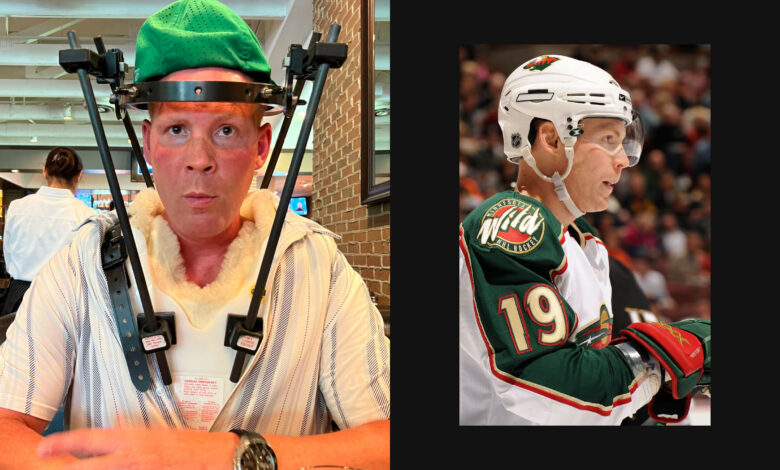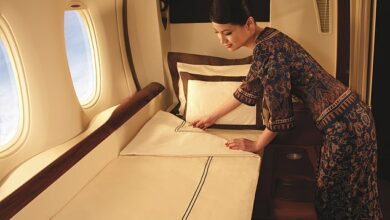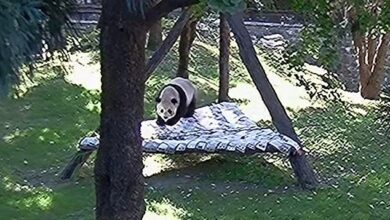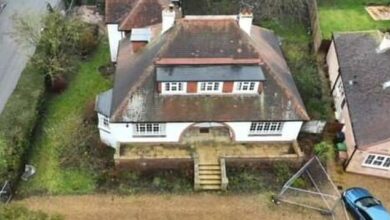Stephane Veilleux on road to recovery after life-threatening car crash: ‘There is no room for self-pity’

EDINA, Minn. — Dropped off at the front of Tavern 23, Stephane Veilleux walks in and looks for a familiar face in one of the booths.
After spotting one across the restaurant, he approaches and says, “Bring it in,” before exchanging an extremely delicate hug.
“Shocking, huh?” he says.
Indeed.
The strong-skating, hard-hitting blue-collar forward somehow managed to avoid major injury over 10 NHL and 17 professional hockey seasons. Now, nine years after his last NHL game, he has been debilitated by an injury that has nothing to do with hockey.
Since a June 19 car crash, the 42-year-old Saint-Georges, Quebec native has been in a halo vest that prevents him from moving his neck, laying down to sleep, driving, showering normally, playing with his two children, going on the ice to coach the dozens of athletes he trains or doing so many other activities he always took for granted.
The seven-pound apparatus is made up of graphite rods and rings that extend from the vest surrounding his chest and abdomen and is screwed into his skull by four titanium pins. The objective is to immobilize his neck so his burst C1 vertebrae has a chance to heal.
The C1 is the ring-shaped bone where the skull and the spine meet. Veilleux broke the vertebrae in multiple spots, and being frank, he says, “I’m lucky to not be paralyzed … or worse.”
The halo is to be burrowed into his skull for at least three months. He’ll have a CT scan on Sept. 17 to see if there’s bone growth. If Hennepin County Medical Center neurosurgeon Thomas Bergman is not satisfied, it would likely mean Veilleux will wear the halo vest for several more months.
“I could be in this a long time,” Veilleux says.
The hope is to avoid surgery where screws and rods attach Veilleux’s skull to his spine. The majority of range in the neck comes from the first few spine bones, so fusing the skull to the spine means losing the majority of mobility in the neck.
Veilleux orders a salmon salad and a large glass of cold milk.
“Got to feed those bones,” he says, showing he hasn’t lost his sense of humor. “I’m trying to support myself with calcium and magnesium and all the natural stuff to heal. No different than when I played hockey with eating and being disciplined.
“I’m attacking this like a hockey player.”
Chatting with The Athletic for more than 90 minutes, it’s clear he’s not bitter.
“I’m going to be a fighter,” he says. “There is no room for self-pity.”
Sure, he has tough days and can get “moody.” Who wouldn’t? But mostly, He’s grateful.
Grateful to be alive. Grateful to the Edina community for taking care of him — providing car rides “and anything we need, especially my kids.” Grateful to the parents of the kids he trains who constantly ask, “How can we help?”
Grateful to the Wild — the team he played 428 of his 506 NHL games with — for assisting with meals for his family and offering doctors to review his X-rays and treatment plan. Grateful to his best friend and old teammate Pierre-Marc Bouchard for always being there to FaceTime. Grateful to his pal Brett Peterson, who was with him during those first 48 hours and refused to leave the room during the tough-to-watch process of attaching the halo.
And mostly grateful to his ex-wife, Amy, the mom to their two kids, 12-year-old Rafael and 10-year-old Viviane.
Amy and Veilleux divorced three years ago, but she was his first phone call after the crash. She has been with him every step of the way, and when he got out of the hospital after 10 days, she allowed him to move back into their home so he could be with their kids and have family to take care of him during this long, grueling process.
“Pretty classy, huh?” Veilleux says. “It speaks to what kind of heart she has. We’re there for each other no matter what.”
It was around 5:30 p.m. on June 19.
Veilleux was driving on a service road near Braemar, heading to back-to-back baseball games — first his son’s, then his daughter’s.
A teenager driving a Toyota Highlander ran a stop sign and T-boned Veilleux’s Nissan Rogue, he says. The police report lists the contributing factor as “failure to yield the right of way” on her part. Veilleux knew immediately something was wrong because he was in pain and couldn’t move his neck, but when he spotted the teenage girl bawling, he got out of his car to console her.
“He was more worried about her than him,” Peterson says.
Veilleux was extremely fortunate not to further damage his C1 vertebrae or sever his spine walking around and then being driven to the hospital rather than by ambulance.
“He is very lucky,” says Megan Boe, a physician assistant at Hennepin County Medical Center who Veilleux initially saw weekly and now sees every two to three weeks to take X-rays and check the alignment of the halo. “People who have fractures to that bone could very easily be paralyzed or even worse. It’s something that can be fatal depending on where that bone fractures, if it hits the spinal cord. If the ligaments are injured enough around that area, it can make the spine very unstable and things slip around. You can hit the spinal cord, too, and that could be catastrophic.
“When he finally got to HCMC and we found out what was going on, our orders are flat bed rest until we get this stabilized.”
Amy Veilleux arrived on the scene in 15 minutes. The mom of a child Veilleux trains spotted the accident and also stopped.
Veilleux’s neck almost created a natural brace. He couldn’t move his neck.
“I thought he just had a pinched nerve or something,” Amy says.
Amy drove him to the emergency room at Two Twelve Medical Center in Chaska, where they waited for three hours to be seen, watching their kids’ baseball games on SportsEngine. Amy finally left to pick them up. Soon after, Veilleux was called in for X-rays.
“After looking at the scan, everybody was like, ‘Oh my God,’” Veilleux says. “They all freaked out and said, ‘We need to rush him to HCMC now!”
Veilleux called Amy, and she called her parents to watch the kids and then drove to downtown Minneapolis.
“The first couple days were lots of ups and downs,” Amy says. “We had doctors come in and say, ‘The way it’s broken, I doubt we’re going to be able to do a halo. Surgery is inevitable,’ which means you would lose all movement (in your neck).
“We reached out to the Wild. I have a friend who works at Mayo, so we started having other doctors start reviewing it, too. But then the chief neuro came in.”
Amy says Bergman told Veilleux, “For everything you’ve done for this city and the (Wild), we’re going to give you the biggest opportunity for it to heal so you can recover as fully as you can, and we’re going to try the halo first.”
Peterson was there, too. They suggested he leave the room during the procedure.
He stayed.
“On one hand, you can’t believe this is how they do it, but on the other hand, what a fantastic invention that this thing could save the guy’s mobility for life,” Peterson says. “You’re witnessing this grotesque, kind of medieval approach to an apparatus. But this thing is remarkable because it gives him a chance to maybe heal. During the entire thing, they’re constantly asking Steph to move his fingers and toes and feet because they’re worried they’re causing the spine to be in further jeopardy while they’re attaching the halo.”
Veilleux’s children were extremely scared at first, “but what a good learning lesson on how for them to face adversity in life,” he says.
“I’m a big believer to talk through things with my kids,” he continues. “They’re able to handle the truth. We’ve sat down with them and had hard conversations, but, of course, they’re kids, right? It’s like, ‘Hey dad, are you going to be able to skate hard again and teach us on the ice and all that?’ So for sure those questions have come and are coming.”
For now, Veilleux sleeps on a rocking recliner in Amy’s living room.
The arrangement makes sense, Amy says, “Because of A) the kids — I mean, the kids were so scared — and B) I live where all of our friends are, and the community and the network. I mean, my friends and family are his friends and family.
“So I didn’t not consider it. It was immediately, ‘When you get out, if you want to come and stay at my place, that’s on the table.’”
And the kids have been a huge help.
One example? The pin sites on Veilleux’s halo must be cleaned twice a day. Where the pins are inserted never heals because there’s a foreign body in the wounds, so the biggest complication with halos is the chance of infection.
Hesitant at first, Rafael now helps clean the pins, which is one less thing on Amy’s plate.
“The love she has for Steph despite the fact that they’re not married anymore is remarkable,” Peterson says. “You would think they were still married just how much empathy she has.”
Veilleux’s entire career was about keeping himself in impeccable shape. As an athlete, he gets antsy just sitting around and doing nothing.
So naturally he still coaches all his kids. He runs them through dryland and sits on the bench during “SV Stingers” tournaments like the recent Easton Cup in Plymouth.
He does 300 lunges a day to keep his lower body in shape and uses bands to keep his upper body in shape. Boe is always advising him to be careful.
“I know that he’s eager to lift weights and things like that,” Boe says. “We’ve had to talk about strict weight restrictions. He’s shown me the lunges he does, but I always worry that he’s going to tip over or fall. I have to remind him, ‘Make sure you’re holding onto something.’ ‘Make sure you’re next to a piece of furniture you can hold onto.’ He actually is listening to us and following everything, even though I can tell it’s not fun for him.
“He’s really motivated for it to heal properly. Whatever we’re asking him to do, he’s doing it to increase his chances of this going well. But I could tell it’s really hard. Like he showed me a video of a particular boxer that had a spine injury lifting weights — a lot of weight — and I told him, ‘You can’t do that!’
“First of all, that guy shouldn’t have been doing that. But also I told him the difference is that guy had a fusion. Steph hasn’t had surgery, so his spine is much more unstable than that man’s was. He can’t be doing that.”
Veilleux’s daughter plays on a baseball team with Vikings coach Kevin O’Connell’s son.
In early July, O’Connell spotted Veilleux at a game wearing the halo and came up to express his sorrow.
Veilleux told O’Connell, “I’m grateful to be alive. It could always be worse.”
A few days later, Vikings rookie defensive back Khyree Jackson died in a car accident in Maryland.
The next time Veilleux saw O’Connell, he went up to the coach to express his condolences and said, “Remember that conversation we had two weeks ago? It could always be worse.”
O’Connell looked at Veilleux and said, “Isn’t that the truth?”
On Thursday, Columbus Blue Jackets star Johnny Gaudreau and his younger brother, Matthew, were killed by a driver who struck them while they were cycling on the side of the road in New Jersey.
“You think about that whole family now and what’s ahead for them, and think, ‘That could have been my family,’” Veilleux says. “Their kids are going to grow up without a father, and that could have been mine. That’s why I’m focusing on gratefulness.
“The Gaudreaus are gone. I got up this morning, and yeah, I’m kind of stuck in my upper body, but I stood up and got a cup of coffee. I’m able to still walk. I’m still alive. My kids still have their dad.”
It’s this attitude that blows everybody away who knows Veilleux.
“I couldn’t do it,” Amy says. “Even the doctors can’t believe how strong he is.”
“I just love the guy,” Peterson says. “I was a Wild season-ticket holder, and before I knew him, I loved what I thought he was. And then to actually get to know him, I realize he’s even better than what I witnessed on the ice.”
Boe says Veilleux’s strength is half the battle.
“It’s a devastating injury, and it impacts your life day to day, and it’s not going to be easy,” Boe says. “There’s so many people we see that just say, ‘Now I can’t do anything,’ and they just mope and think it’s awful and often have a hard time understanding how much worse it could have been.
“But (Veilleux) understands that even though it doesn’t look like he’s lucky, he is lucky. He wants to go back to coaching kids and everything he was able to do in his previous life. It’s inspiring to watch.”
Veilleux has been hired to coach a new professional three-on-three Major League Hockey team that he expects to start at Aldrich Arena in Maplewood next fall.
Mostly, he can’t wait to skate with his kids again.
“I surprise myself how I remain patient,” Veilleux says. “Look, life is hard. Everyone is battling something. Every one of us. This is my battle now. I am optimistic. I’m staying positive. It is a little scary to know what the outcome could be if I need surgery, but I’m built to be strong.
“So I’m going to attack this. And I’m coachable. I just follow the instructions of the neurospecialists. I have no other choice but to hope it heals. And it will. I really believe that.”
(Top photos: Michael Russo / The Athletic and Harry How / Getty Images)








